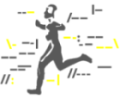





Search | Sitemap | Navigation |  |
|
||||||||||||||||||||||||||
|
||||||||||||||||||||||||||
|
||||||||||||||||||||||||||
|
Of mice and migraines
By Edward Chronicle
This year's [2004] meeting of the American Headache Society was held in Vancouver, Canada, June 10th to June 13th. Several of the invited presentations focused on the importance of the migraine aura, and it seems as if the migraine research community worldwide is becoming increasingly interested in aura.
Two presentations are particularly noteworthy. Professor Michael Moskowitz (Harvard University, USA) gave a very compelling overview of the relationship between current findings in the genetics of migraine and the pathophysiology of spreading depression. Geneticists have in recent years found two mutations, on chromosomes 1 and 19, that appear to be responsible for familial hemiplegic migraine (FHM), a rare variant of migraine. It has been a matter of great debate as to whether the genes for FHM are likely to be the same as those for regular migraine (with or without aura). Professor Moskowitz outlined an elegant neurobiological model demonstrating how the two ion-channel dysfunctions caused by FHM mutations are likely to make the brain susceptible to cortical spreading depression (CSD). CSD is the brain mechanism most likely to be responsible for the visual aura of migraine.
Professor Michel Ferrari (Leiden University, The Netherlands) summarized recent progress in work towards developing animal models of migraine. Hitherto, there has been no animal equivalent of migraine, and it can be argued that this has hindered research. Professor Ferrari's group has been successful in engineering a genetically altered mouse with one of the FHM mutations mentioned above. Various experiments convincingly demonstrate that these genetically engineered mice exhibit cortical hyperexcitability, and are more susceptible to CSD. This work fits nicely with both human data demonstrating cortical hyperexcitability in migraine patients, and computational modeling work in which the spread of CSD depends upon excitability parameters in the model.
It seems very likely that the increased focus on the aura phase of migraine, and the integrative models discussed at the meeting, will give rise to the development and marketing of new drugs for the prevention of migraine. One pharmaceutical company, GlaxoSmithKline, has recently synthesized a new family of compounds that block CSD in animals via a novel mechanism. It remains to be seen whether CSD-blocking drugs are efficacious and well tolerated in human patients.
References
van den Maagdenberg AMJM et al. A Cacna1a knockin migraine mouse model with increased susceptibility to cortical spreading depression. Neuron 2004; 41: 701-710.
Moskowitz MA, Bolay H, Dalkara T. Deciphering migraine mechanisms: Clues from familial hemiplegic migraine genotypes. Annals of Neurology 2004; 55: 276-280.
Author: Prof. Edward P. Chronicle, PhD
Last modification of this page: Wed. June 23. 2004
 Top of the page
Top of the page| · | News |
| · | Medical Professionals |
| · | Medical Studies |
| · | Familial Hemiplegic Migraine |
| · | Genetics |
Copyright © 2005 Migraine Aura Foundation, All rights reserved. Last modification of this site: August 25, 2006
Thanks to: RAFFELT MEDIENDESIGN and GNU software | webmaster@migraine-aura.org
http://migraine-aura.org/EN/AHS_Meeting_2004.html


